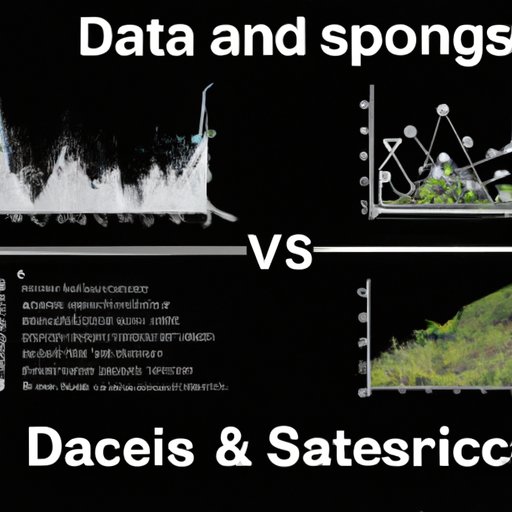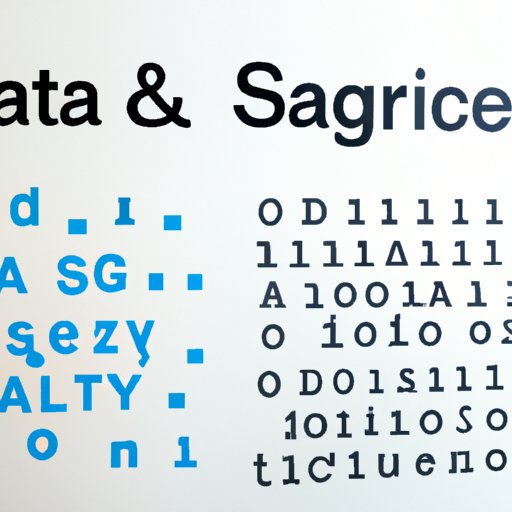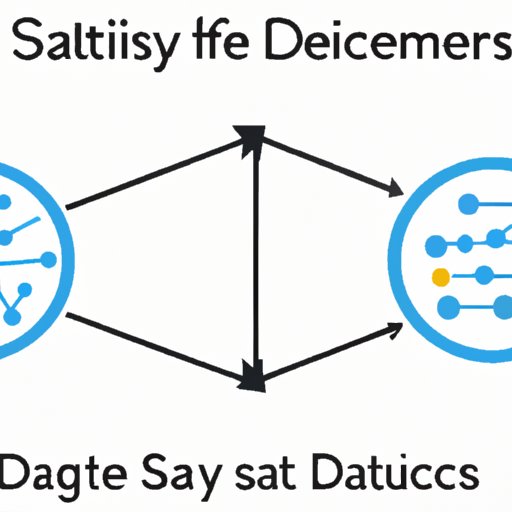Introduction
Data science and data analytics are two related but distinct fields that are often misunderstood or used interchangeably. Although both disciplines involve working with data, there are important distinctions between them that need to be understood in order to identify the best approach for solving a particular problem. This article will explore the definitions of data science and data analytics, compare the two disciplines, and discuss their relationship and roles in business.

A Comparison of Data Science and Data Analytics
In order to better understand the similarities and differences between data science and data analytics, it is important to first define each term.
What is Data Science?
Data science is the study of large datasets with the goal of uncovering patterns, trends, and correlations. It involves complex data mining techniques such as machine learning and artificial intelligence in order to analyze and interpret data. Data scientists use this information to make predictions about the future and provide insights that can help businesses make better decisions.
What is Data Analytics?
Data analytics is the process of collecting, organizing, and analyzing data in order to gain insights into a particular problem or question. It involves using statistical methods and software tools to examine large datasets and identify patterns and trends. The goal of data analytics is to find actionable insights that can help improve business performance.
Key Differences Between Data Science and Data Analytics
The primary difference between data science and data analytics is the scope of the disciplines. Data science is focused on exploring and understanding large datasets, while data analytics is focused on finding actionable insights from that data. Additionally, data science is more focused on predictive models and forecasting, while data analytics is more focused on descriptive models and reporting. Finally, data science requires a deeper technical understanding of the data and complex mathematical techniques, while data analytics relies more heavily on software tools and basic statistical analysis.
Exploring the Relationship Between Data Science and Data Analytics
Although data science and data analytics are two distinct disciplines, they are closely related and complementary. Both disciplines work to identify patterns and trends in data, though they do so in different ways. By combining the strengths of both disciplines, organizations can gain a more comprehensive view of their data and unlock powerful insights.
Commonalities of the Two Disciplines
Data science and data analytics share many of the same goals and objectives. Both disciplines strive to make sense of large datasets and uncover hidden patterns and trends. They also both rely on the same underlying technologies and tools, such as machine learning and artificial intelligence. Additionally, both disciplines require an understanding of statistics and probability theory.
How Data Science and Data Analytics Complement Each Other
Data science and data analytics can be used together to create a more comprehensive picture of a dataset. For example, data science can be used to explore the data and identify potential relationships and correlations. Data analytics can then be used to confirm these relationships and identify actionable insights. By combining the two disciplines, organizations can gain a deeper understanding of their data and make better-informed decisions.
The Role of Data Science vs Data Analytics in Business
Data science and data analytics have become increasingly important in today’s business environment. As organizations collect and store more data, they need effective tools and techniques to make sense of it. Data science and data analytics provide the necessary tools and skills to do just that.
Applications of Data Science in Business
Data science is used by businesses to uncover insights from large datasets. It can be used to predict customer behavior, identify customer segments, and optimize marketing campaigns. Additionally, data science can be used to develop predictive models for forecasting sales and predicting future trends. Finally, data science can be used to detect fraud and anomalies in data.
Applications of Data Analytics in Business
Data analytics is used by businesses to gain insights from data. It can be used to segment customers, monitor performance, and track key metrics. Additionally, data analytics can be used to analyze customer feedback, identify areas of improvement, and measure the success of campaigns. Finally, data analytics can be used to generate reports and dashboards for measuring and tracking progress.

Data Science and Data Analytics: Two Different Disciplines With a Common Goal
Data science and data analytics are two distinct disciplines, but they share a common goal: to make sense of data and uncover insights that can help businesses make better decisions. Although they have different approaches and applications, they can be used in tandem to gain a more comprehensive understanding of data.
Benefits of Using Both Disciplines
Using both data science and data analytics can provide a number of benefits to organizations. By combining the two disciplines, organizations can gain a more comprehensive view of their data and uncover deeper insights. Additionally, using both disciplines can help organizations save time and resources by avoiding unnecessary data processing and analysis. Finally, using both disciplines can improve decision making by providing a more complete picture of the data.
Challenges of Integrating Both Disciplines
Integrating both data science and data analytics can also present some challenges. Organizations must ensure that the data is properly collected and stored in order for the analysis to be accurate. Additionally, organizations must have the right skills and expertise to implement both disciplines effectively. Finally, organizations must have the proper infrastructure and tools in place in order to successfully integrate both disciplines.

Understanding the Intersection of Data Science and Data Analytics
Data science and data analytics are two distinct disciplines, but they are closely related and complimentary. By understanding the similarities and differences between the two disciplines, organizations can better utilize both disciplines to make better decisions.
Impact of Data Science and Data Analytics on Decision Making
Data science and data analytics can have a significant impact on decision making. By combining the two disciplines, organizations can gain a more complete understanding of their data and uncover valuable insights. This can help organizations make more informed decisions that are based on data rather than intuition. Additionally, data science and data analytics can help organizations reduce risk by providing accurate forecasts and predictions.
Future of Data Science and Data Analytics
Data science and data analytics are becoming increasingly important in today’s business environment. As organizations continue to collect and store more data, the need for effective tools and techniques to make sense of it will only grow. Data science and data analytics will play an even larger role in helping organizations unlock the value of their data and make better decisions.
Conclusion
Data science and data analytics are two distinct yet related disciplines that can be used together to gain a more comprehensive understanding of data. While data science focuses on exploring and understanding large datasets, data analytics focuses on finding actionable insights from that data. By understanding the similarities and differences between the two disciplines, organizations can better utilize both disciplines to make better decisions.
Summary of Data Science vs Data Analytics
Data science and data analytics are two related but distinct disciplines that are often misunderstood or used interchangeably. Data science is focused on exploring and understanding large datasets, while data analytics is focused on finding actionable insights from that data. Both disciplines strive to make sense of large datasets and uncover hidden patterns and trends, though they do so in different ways. By combining the strengths of both disciplines, organizations can gain a more comprehensive view of their data and unlock powerful insights.
Recommendations for Utilizing Both Disciplines
Organizations should consider using both data science and data analytics in order to gain a more comprehensive understanding of their data. They should ensure that the data is properly collected and stored in order for the analysis to be accurate. Additionally, organizations should have the right skills and expertise to implement both disciplines effectively. Finally, organizations should have the proper infrastructure and tools in place in order to successfully integrate both disciplines.
(Note: Is this article not meeting your expectations? Do you have knowledge or insights to share? Unlock new opportunities and expand your reach by joining our authors team. Click Registration to join us and share your expertise with our readers.)
